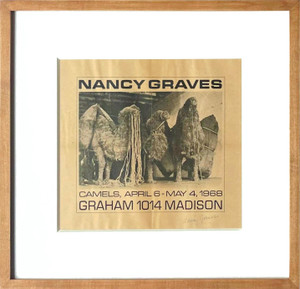
Nancy Graves
5745, for the Jewish Museum, 1984
Silkscreen on paper
Signed, numbered 5/90 and dated in graphite pencil on the front; bears publishers' blind stamp front left corner
30 1/4 × 40 1/2 inches
Unframed
Commissioned by the Mr. and Mrs. Albert A. List Graphic Fund for The Jewish Museum, New York
Signed, numbered and dated in graphite pencil on the front; bears publishers' blind stamp front left corner. Commissioned by the Mr. and Mrs. Albert A. List New Year's Graphic Fund for The Jewish Museum, New York. During the 1980s, various artists were commissioned to create a print celebrating the Jewish New Year. This is the silkscreen renowned sculptor Nancy Graves created to celebrate the year 5745 of the Jewish Calendar, beginning in September 1984 (Rosh Hashanah). This work was published in a limited edition of 90. The number 90 has special significance in Jewish gamatria (numerology) for several reasons, including the fact that it equals five times life - or Chai. The number for Chai, meaning "Life " s 18, and 18 x 5 = 90. This is a magical number in Judaism. All of the works were published in editions that were multiples of 18, or the Life. In her lifetime, Nancy Graves did not receive the renown or acknowledgement that her ex-husband and former Yale School of Art classmate Richard Serra did, but she is finally getting the recognition she richly deserves.
Biography: Nancy Graves (1939 – 1995) is an American artist of international renown. A prolific cross-disciplinary artist, Graves developed a sustained body of sculptures, paintings, drawings, watercolors, and prints. She also produced five avant-garde films and created innovative set designs.
Born in Pittsfield Massachusetts, Graves graduated from Vassar College in 1961. She then earned an MFA in painting at Yale University in 1964, where her classmates included Robert Mangold, Rackstraw Downes, Brice Marden, Chuck Close, as well as Richard Serra with whom she was married from 1964 to 1970. Five years after graduating, her career was launched in 1969 when she was the youngest artist — and only the fifth woman — to be selected for a solo presentation at the Whitney Museum of Art. Graves’ work was subsequently featured in hundreds of museum and gallery exhibitions worldwide, including several solo museum exhibitions. She was awarded commissions for large-scale site-specific sculptures and her work is in the permanent collections of major art museums. A frequent lecturer and guest artist, her work was widely documented during her lifetime. In 1991 she married veterinarian Dr. Avery Smith. Graves travelled extensively and was fully engaged with the cultural and intellectual issues of her times. Her brilliant career and life were cut short by her untimely death from cancer at age 54.
From a point of view that she described as “objective,” Graves transformed scientific sources, such as maps and diagrams, into artworks by re-producing their complex visual information in detailed paintings and drawings. Investigating the intersections between art and scientific disciplines, Graves created compelling, formally rigorous, yet ultimately expressive works of art that examine concepts of repetition, variation, verisimilitude, and the presentation and perception of visual information.
Based in SoHo, New York, Graves gained prominence in the late 1960s as a post-Minimalist artist for innovative camel, fossil, totem, and bone sculptures that were hand formed and assembled from unusual materials such as fur, burlap, canvas, plaster, latex, wax, steel, fiberglass and wood. Made in reaction to Pop and Minimalism, these works reference archaeological sites, anthropology, and natural science displays. Suspended from the ceiling or clustered directly on the floor, these early sculptures also engage with Conceptualist ideas of display. For her Whitney Museum presentation Graves exhibited three seemingly realistic sculptures of camels in an installation that evoked taxidermy specimens and questioned issues of verisimilitude in art and science, particularly in light of their hand patched and painted fur surfaces. The exhibition elicited wide spread critical responses and established her artistic significance.
After intensely engaging with sculpture in the early 1970s, Graves returned to painting. Her detailed pointillist canvasses re-produced — in paint — images culled from documentary nature photographs, NASA satellite recordings, and Lunar maps, commingling scientific exactitude with abstraction. Resuming sculpture in the late 1970s, Graves was among the first contemporary artists to experiment with bronze casting. She re-invigorated the traditional lost wax technique by assembling cast found objects into unique improbably balanced sculptures, with bright polychrome surfaces and distinctive patinas.
Throughout the 1980s Graves became widely recognized for her increasingly large and graceful open-form sculpture commissions. At the same time, she also expanded her drawing, painting, and printmaking practice and made large gestural watercolors. Then, in the late 1980s she created wall-mounted works that combined her explorations of sculpture, painting, form and color. In these large-scale pieces, she mounted high relief polychrome sculptural elements to the surfaces and edges of painted shaped canvases so that patterned shadows were cast onto the paintings and surrounding wall.
By the 1990s Graves was casting in glass, resin, paper, aluminum, and bronze, combining these varied materials and colors into daring sculptures with moving parts. As she proceeded in all the media she mastered, Graves increasingly re interpreted and transmuted forms sourced from her own earlier artwork — rather than from outside research — creating elaborate compositions that form a layered a-temporal archaeology of her own visual production.
Nancy Graves’ pioneering art anticipated ideas being explored by artists today such as data mining, multi disciplinarity, technology, and research-based art. Her work addresses philosophical, perceptual, aesthetic and technological issues that are especially relevant to making art in the digital age. - Courtesy Nancy Graves Foundation








